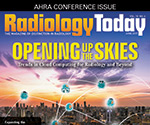 |
Breakthrough in Delirium Research ‘Solves 2,500-Year-Old Mystery’
Researchers in New South Wales, Australia, have made a breakthrough in identifying the cause of delirium in elderly patients. By using PET scans, the researchers identified abnormal glucose metabolism in the brains of patients who developed delirum, ABC News Australia reports.
‘Wearable’ Brain Scanner Holds Potential to Study a Variety of Brain Conditions
As Radiology Today reported in November 2016, scientists have developed a miniaturized PET brain scanner to study the links between movement and brain activity. The scanner can be worn like a helmet, allowing research subjects to make movements while the device scans. R&D Magazine weighs in with the latest in this intriguing field.
Trial Evaluating Safety of Focused Ultrasound in Alzheimer’s Patients
A first-ever clinical trial evaluating the safety and feasibility of opening the blood-brain barrier in Alzheimer’s disease patients using focused ultrasound is underway at Sunnybrook Health Sciences Centre in Toronto, Canada, according to Alzheimer’s News Today. Previous trials on animals showed that opening the blood-brain barrier using this method can allow immune cells to cross into the brain.
Medical Imaging Goes to the Movies
To add detail and depth beyond what is possible with today’s volume-rendered images, researchers in Austria have adopted “cinematic rendering,” a technique straight out of Hollywood, to allow clinicians to control how much light is cast on different parts of 3D medical images. As Undark.org reports, the technique could help doctors better plan difficult surgeries. |
 |
 |
“It’s very simple. If JPL has a bunch of technology—to get to the moon, to look for life on Europa—and that has any benefit for medicine and health, then we have a responsibility to share that benefit with the public.”
— Leon Alkalai, PhD, a veteran technologist at NASA’s Jet Propulsion Laboratory, on sharing with the medical field the technology NASA uses to explore the cosmos, specifically the Cassini probe, which is now using some of its space exploration technology to study the microbiome in breast duct fluid, as reported by STAT |
 |
 |
| Radiology Today's online gift shop features a wide variety of items for radiology professionals. Choose from t-shirts, journals, clocks, buttons, mouse pads, and much more! Check out our secure online shop today or call toll-free 877-809-1659 for easy and fast ordering. |
 |
|
|
 |
Have a product or service you want to market to radiology professionals or an open position that you need to fill quickly? Radiology Today offers many flexible advertising programs designed to maximize your results. From print advertising to e-newsletter sponsorships, website advertising to direct mail opportunities, Radiology Today helps achieve your goals. E-mail our experienced account executives today for more information or call 800-278-4400!
Coming up in our July issue is our AHRA Product Showcase. Contact sales for more information.
AlliedHealthCareers.com is the premier online resource to recruit radiology professionals. Post your open positions, view résumés, and showcase your facility's offerings all at AlliedHealthCareers.com!
Radiology Today's Physician
Recruitment Center gives physician recruiters a powerful tool to satisfy their current needs. An ideal option for recruiters looking to fill partnership opportunities, academic appointments, and hospital staff positions, the Physician Recruitment Center is visited regularly by radiologists and other imaging physicians during their frequent trips to our website for the best coverage of industry news and trends. |
 |
 |
 |
Set up Job Alerts and create your online Résumé
to let potential employers find you today! |
 |
|
